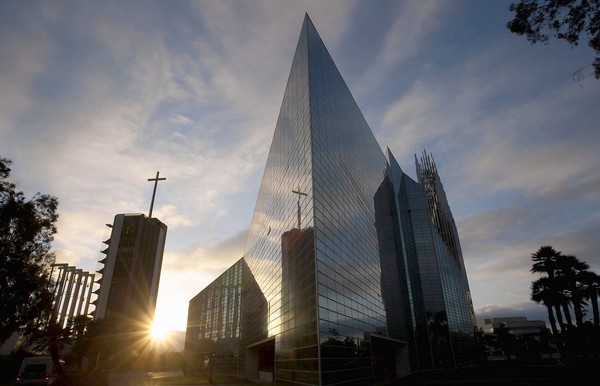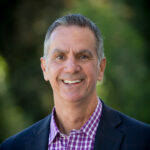This post originally appeared at Trans/Missions, the USC Knight Chair in Media and Religion site.
The Crystal Cathedral has finally met its demise. After bankruptcy, the sale of the landmark sanctuary to the Orange County Roman Catholic Diocese and now the (somewhat ungraceful) exit of the entire Schuller family, the fate of the formerly iconic megachurch has been sealed. Whatever the future holds, the cathedral will likely no longer enjoy its identity of the past 40 years—a cultural landmark melding Christianity, American consumerism and celebrity.
The Crystal Cathedral story has been unfolding for the past several years. Robert Schuller (senior) first brought in his son, Robert A. Schuller, to take over as the church’s figurehead and leader. Schuller fils was replaced by his sister, followed by the bankruptcy filing, the sale of the church’s property and ultimately a Schuller-less church. Over that time, I have spoken to many reporters—both local and national—about the slow decline of the Crystal Cathedral. Their questions always focus on the future of the congregation and, more generally, what the story portends for the future of Christianity in America.
Does the demise of the Crystal Cathedral mean the end of megachurches in America? Not long ago, I wrote a short column about the potential cultural meaning of the fall of the Crystal Cathedral. I was surprised by how eager the editors were for me to frame the piece as the beginning of the end of the megachurch era. The story only seems to attract attention because of its strange combination of phenomenal spiritual success followed by decline and demise, all spiced with internal family conflicts and the not-so-subtle hint of greed and desire for fame that lies at the core of the Crystal Cathedral ethos. This mode of storytelling allows journalists to deploy the easy journalistic tropes of scandal, conflict and blood (however figurative the bloodletting may be).
Meanwhile, just up the Golden State Freeway from the Cathedral’s home in Garden Grove, the Los Angeles City Council has been working on an important but complex redistricting plan. Buried two-thirds of the way into a recent Los Angeles Times story recounting the final approval of the plan were quotations from two of “several African American pastors” who were in attendance at the City Council meeting. These pastors spoke against the plan as it would, from their point of view, adversely impact the economic growth and development of large swaths of South Los Angeles.
After a bit of sleuthing, I determined that these pastors of medium-size African American congregations are acting as earnest advocates on behalf of their congregants and the surrounding communities. They are not famous, and the word “mega” does not figure into their modest stories–yet their actions and the cultural trends that they represent have enormous political implications citywide and beyond. Relegating these “several African American pastors” at the City Council meeting to the periphery of a local story overlooks what they and others like them are working to accomplish in the public sphere at a time when there are few other voices speaking to the needs and interests they represent.
These two stories, coming as they did within days of each other, got me wondering whether Robert Schuller, Rick Warren, Joel Osteen or any other megachurch pastor has ever attended a meeting of any public agency to speak as a proxy for his or her flock. And if so, was the purpose of that advocacy to help communities that feel left out or left behind, or for something that would primarily benefit their own congregation (like getting zoning laws changed to allow for more parking spaces)?
Megachurches actually represent of a fairly narrow slice of American religion—generally white, middle class and suburban—and tend not to be particularly interested in or involved with the life of their geographic communities. While ignoring megachurches would be folly, overlooking less obvious but more demographically diverse religious players is equally foolhardy. Megachurches may be titillating in their excesses, but the bigger story is with the other (and smaller) religious congregations that populate the American religious ecology. If reporters are really interested in the future shape of American religion, they need to look beyond the obvious for something more nascent and subtle. Look for what’s sprouting rather than focusing on what is, arguably, past its prime.
Richard Flory is the executive director of the USC Center for Religion and Civic Culture.







